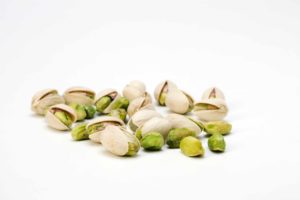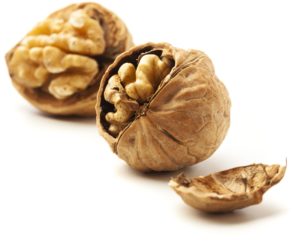 Rich in energy, protein, antioxidants, vitamins, minerals as well as omega-3 fatty acids, there can be little doubt that a few nuts can only be good for you.
Rich in energy, protein, antioxidants, vitamins, minerals as well as omega-3 fatty acids, there can be little doubt that a few nuts can only be good for you.
Somehow nuts seem to have fallen foul of the diet brigade – labeled as being fattening, but this has been taken out of context. Nuts do have fat in them, but it’s monounsaturated fatty acids, which help to lower LDL or ‘bad’ cholesterol and increase HDL or ‘good’ cholesterol.
They are rich source of omega-3 essential fatty acids, which have an anti-inflammatory action offering some benefits in conditions such as rheumatoid arthritis, depression and Alzheimer’s disease. Not only that, they are a rich source of minerals like manganese, potassium, calcium, iron, magnesium, zinc, fluoride and selenium. And – there’s more! – they also have high levels of vitamin E and B-complex vitamins.
So, while they contain fat, it can be considered good fat, though it is still calorific. A few handfuls of nuts every now and then can only be good for you. But if you’re calorie counting, then you might want to look at exactly which nuts you’re having a handful of. There are 204 calories in 1oz (10-12 while kernels) of macadamia nuts, while an ounce of peanuts is 166 calories, while raw cashew nuts have 157 cals per oz.
Walnut veneer
While one type of nut will have most of the above, some nuts have certain attributes in abundance. Walnut is almost as well-known as a wood as a seed – and the nuts do come under the ‘tree nut’ family, which includes Brazil nuts, cashews, hazelnuts, macadamias, pecans and pistachios.
 Walnuts seem to lead to decreased ‘bad’ cholesterol, lower total cholesterol while increasing omega-3 fatty acids in red blood cells. An adequate intake of omega-3s, such as those in walnuts, has been shown to help improve a wide variety of cardiovascular functions, including blood pressure.
Walnuts seem to lead to decreased ‘bad’ cholesterol, lower total cholesterol while increasing omega-3 fatty acids in red blood cells. An adequate intake of omega-3s, such as those in walnuts, has been shown to help improve a wide variety of cardiovascular functions, including blood pressure.
Studies in America, where Type 2 diabetes is an epidemic, have linked adding walnuts to the diet to a decrease in fat around the midriff (abdominal adiposity) and possibly contributing to a lessening in the risk factors of cardiovascular problems in people with T2 diabetes, who are prone to such conditions. Other studies have indicated that 1oz of tree nuts a day should be in your daily diet – have a handful, or add to cooking or chop and put in a salad.
Different measurements on blood vessel functioning (including their measurement by ultrasound) show a relatively small amount of daily walnut intake (1-2 oz) provide significant benefits for people with Type 2 diabetes. Better blood fat composition (including less LDL cholesterol and less total cholesterol) has also been demonstrated in people with Type 2 diabetes who’re eating walnuts daily.
 Research has also shown, possibly against more broadly held beliefs, that walnuts might support weight loss and prevent weight gain and obesity. Researchers have linked obesity (and type 2 diabetes) to chronic inflammation, and walnuts are unique in their collection of anti-inflammatory nutrients –omega-3 fatty acids, tannins, flavonoids and other anti-inflammatory phytonutrients. These anti-inflammatory benefits can overshadow the high-calorie and high-fat risk posed by walnuts. While you can overeat walnuts, most everyday diets could remain correctly balanced in terms of calories and fat while still including fairly generous amounts of walnuts (1-3 oz).
Research has also shown, possibly against more broadly held beliefs, that walnuts might support weight loss and prevent weight gain and obesity. Researchers have linked obesity (and type 2 diabetes) to chronic inflammation, and walnuts are unique in their collection of anti-inflammatory nutrients –omega-3 fatty acids, tannins, flavonoids and other anti-inflammatory phytonutrients. These anti-inflammatory benefits can overshadow the high-calorie and high-fat risk posed by walnuts. While you can overeat walnuts, most everyday diets could remain correctly balanced in terms of calories and fat while still including fairly generous amounts of walnuts (1-3 oz).
While nuts in themselves can be good for you, another way to use them is as oils. Many nuts can be pressed and their oils, including macadamia, walnut, peanut, hazelnut, avocado and almond, used in cooking and can be especially flavourful dressings for salads.
NUTRITION
100g of mixes nuts, oil roasted with salt added 600k calories, 54g fat (83% RDA), 21g carbohydrates, calcium 11%, Iron 14% Vitamin B-6 20%, Magnesium 57%. Per cent Daily Values are based on a 2,000 calorie diet.
Food features and recipes like this appear in the Desang Diabetes Magazine, our free-to-receive digital journal. We cover diabetes news, diabetes ‘kit’ and information on food suitable for maintaining good blood glucose control or a diabetic diet, including a regular Making Carbs Count column. It’s free! Go to the top of this page to sign up – we just need your email address. See current and past issues at
www.desang-magazine.co.uk
Open publication

